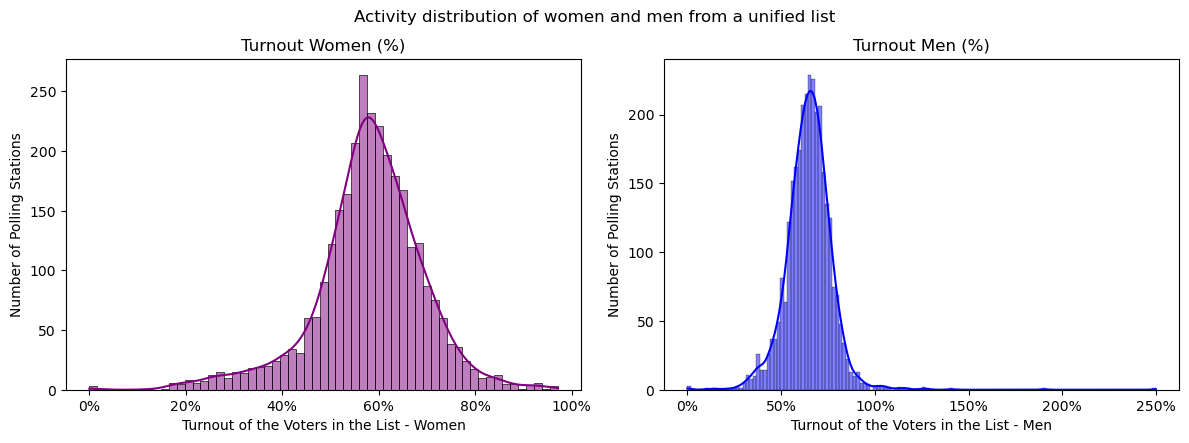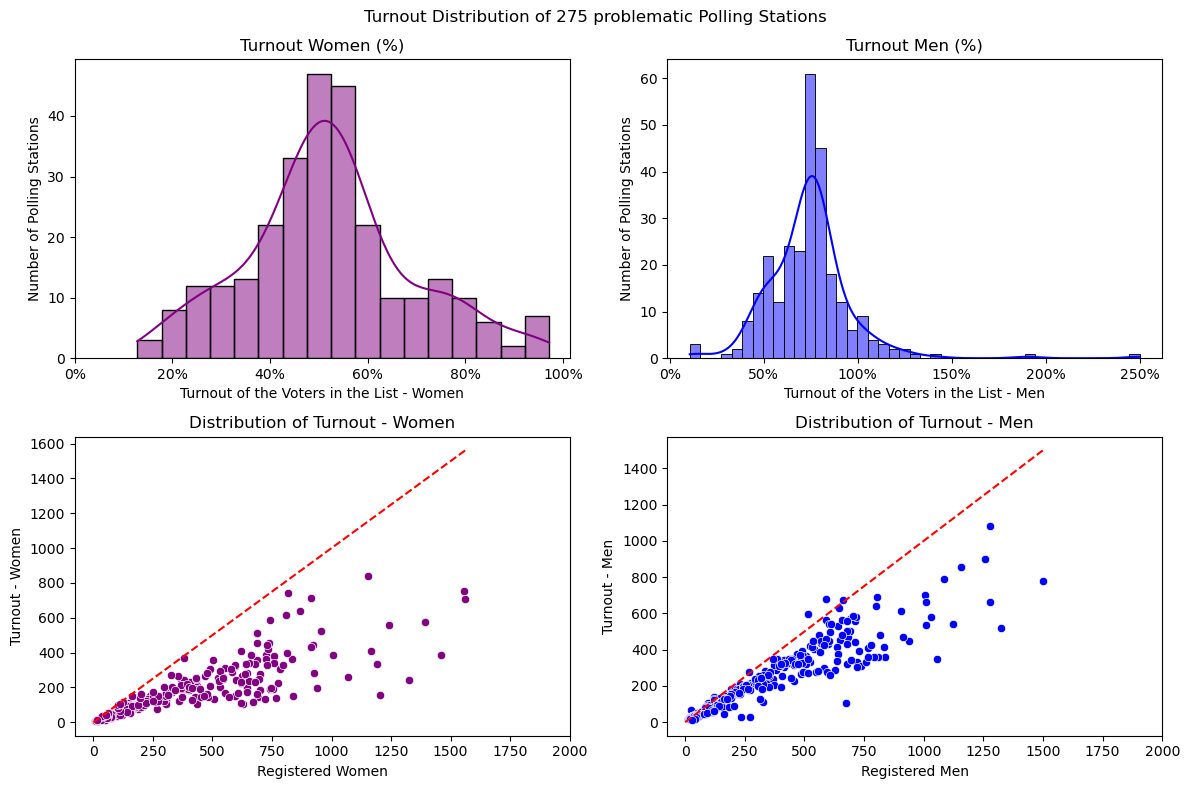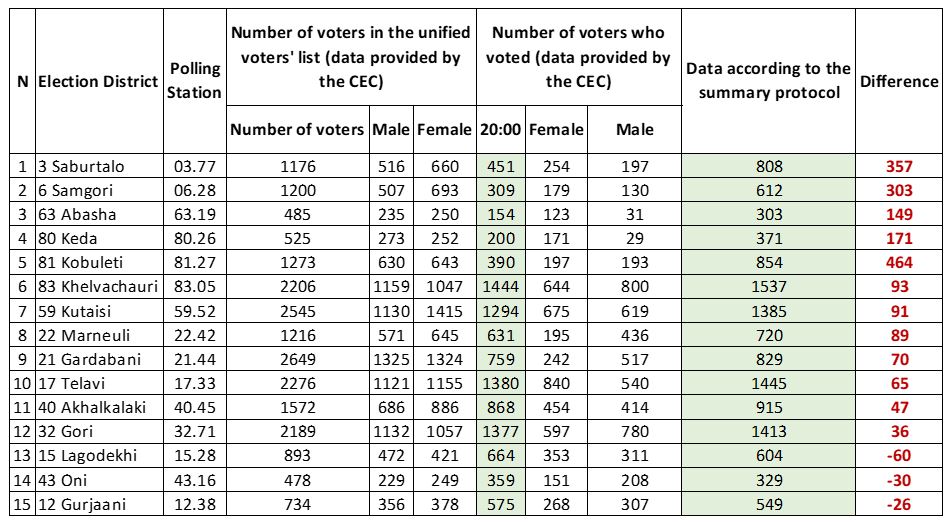According to ISFED's observation, the difference between turnout rates of male and female voters at a significant number of polling stations deviates from the normal distribution and exhibits practically improbable characteristics
The International Society for Fair Elections and Democracy (ISFED) observed a notable tendency when analyzing the data published by the Central Election Commission (CEC) on its website regarding the gender characteristics of voter turnout in the October 26 parliamentary election, which, in some election districts, showed significant differences between the turnout rates of registered male and female voters.
For a more detailed analysis, ISFED additionally requested information from the CEC regarding the gender of voters who participated in the October 26 election based on data from all polling stations established within the country. The initial analysis of the provided data revealed that, in many polling stations, the difference in female and male voter turnout rates deviates from the normal distribution and displays characteristics that are practically improbable or unnatural. For example, in 62 polling stations where male voter turnout from the registered list is between 80 and 100 percent, the average turnout for female voters is up to 57%. In addition, male voter turnout reaches a theoretically improbable level in some polling stations. Namely, according to the provided information, the turnout rate of male voters at certain polling stations is higher than 100%, meaning that the number of male voters who cast ballots surpasses the total number of male voters registered on the unified and special lists for the polling station. If valid, such illogical data indicates manipulations occurring at these polling stations.

Distribution of female and male turnout rates from a unified list
As a result of the analysis of the data provided by the CEC for ISFED, it was revealed that:
- At275 polling stations, the difference between the turnout rates of male and female voters from the unified list exceeds 20 percentage points. Among these, such a deviation in 243 polling stations is caused by a higher male voter turnout rate, while in 32 polling stations by a higher female voter turnout;
- Ofthe given 275 polling stations, in 67 polling stations, the male voter turnout rate exceeds that of female voters by more than 30 percentage points, while in 12 polling stations, the female voter turnout is higher than that of male voters by the same margin;
- At23 polling stations, the number of male voters who participated in the election exceeds the number of males registered in these polling stations' unified lists. Among these, at least 6 polling stations show a male voter turnout higher than 100%, even under the theoretical assumption that all voters registered in the special list at these stations were men.
Polling stations that deviate from logical limitations
Along with this, ISFED identified several inexplicable inconsistencies in the data provided by the CEC. Namely, according to the information published on the CEC website regarding voter turnout in the October 26 election, 961,751 females and 1,098,661 males, totaling 2,060,412 voters, participated in the parliamentary election across the country. The analysis of the requested information by polling stations showed that the number of female voters participating in the election has increased in most districts, in contrast to the number of male voters, compared to the data published on the website. According to this data, the number of female voters participating in the election is 1,053,662, and the same number of male voters is 1,009,686 (a total of 2,063,348 voters). Overall, an increase of 91,911 female voters and a decrease of 88,975 male voters was recorded. In some cases, specifically in 10 election districts, inconsistencies were also found in the data regarding the total number of voters participating in the election. Among them, the most significant discrepancy was observed in the #22 Marneuli election district, where, according to the CEC's information of October 26, 41,766 voters participated in the election. However, the latest data shows that this number is 43,858. It should be noted that after ISFED requested detailed information specified by polling stations, the initial data on voter turnout became unavailable on the CEC website, and the updated turnout rates have been uploaded to the same link, which matches the provided data by election districts. However, the gender composition of voters still has changed in 15 election districts. All of this raises questions with the Election Administration.
ISFED additionally requested information about special lists of voters from the CEC. Considering this, the organization will release the updated and final results later.
Female and male voter turnout rates from the unified list of voters by election districts

Additionally, it should be noted that in the document provided by the CEC, in a significant number of polling stations, the data on the total number of voters participating in the election does not match the total number of voters given in the official results summary protocols published on the CEC website.
For example, we present the discrepancies in 15 election districts:
Attachments:
The data published on the CEC website on October 26
The data on polling stations sent by the CEC to ISFED on November 4




